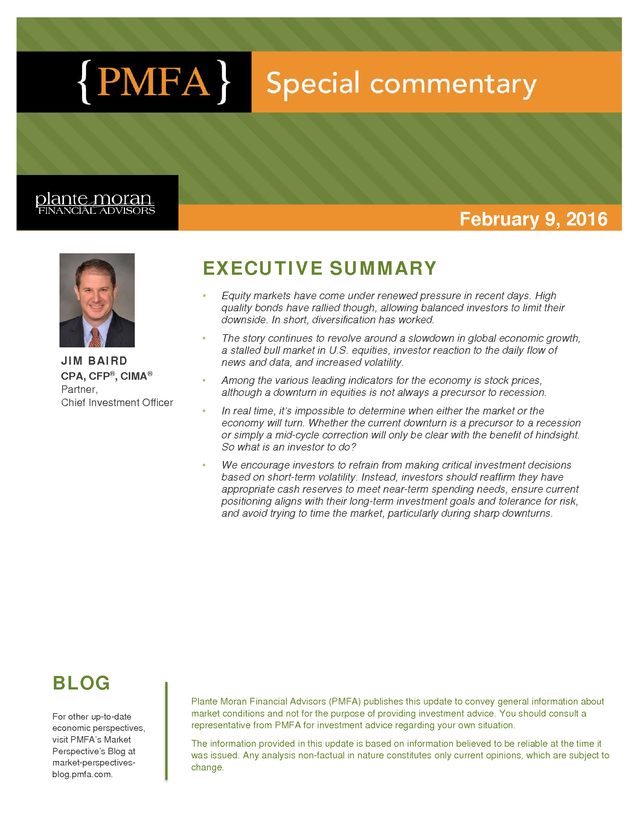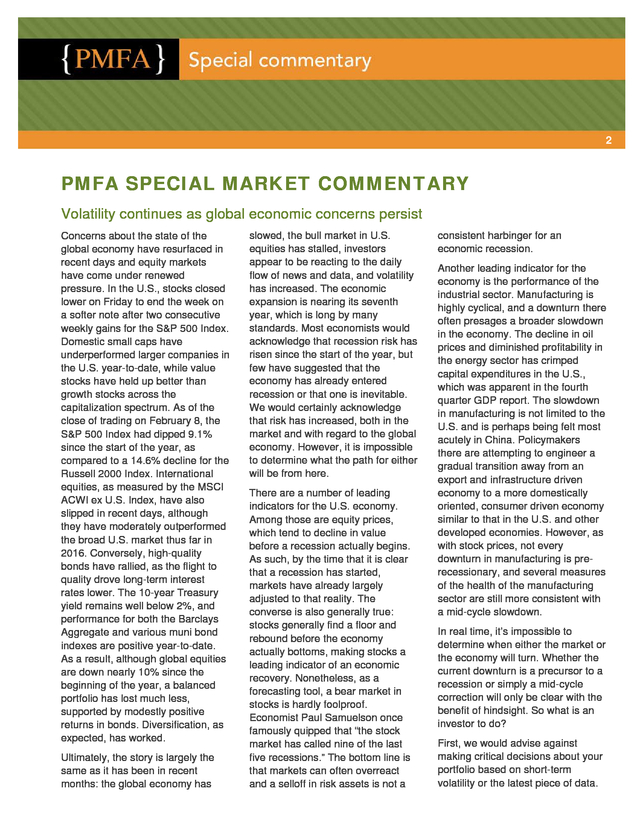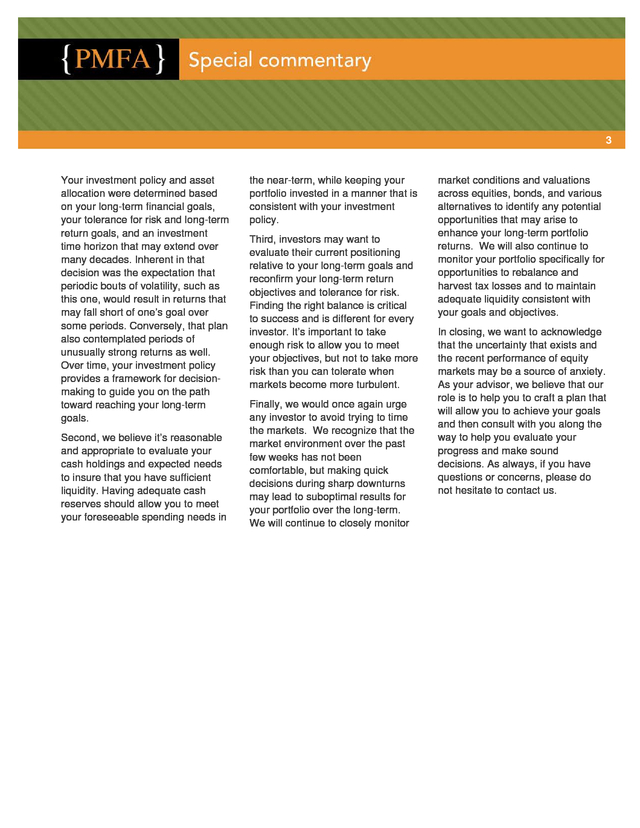Description
February 9, 2016
EXECUTIVE SUMMARY
•
Equity markets have come under renewed pressure in recent days. High
quality bonds have rallied though, allowing balanced investors to limit their
downside. In short, diversification has worked.
•
The story continues to revolve around a slowdown in global economic growth,
a stalled bull market in U.S. equities, investor reaction to the daily flow of
news and data, and increased volatility.
•
Among the various leading indicators for the economy is stock prices,
although a downturn in equities is not always a precursor to recession.
•
In real time, it’s impossible to determine when either the market or the
economy will turn.
Whether the current downturn is a precursor to a recession or simply a mid-cycle correction will only be clear with the benefit of hindsight. So what is an investor to do? • We encourage investors to refrain from making critical investment decisions based on short-term volatility. Instead, investors should reaffirm they have appropriate cash reserves to meet near-term spending needs, ensure current positioning aligns with their long-term investment goals and tolerance for risk, and avoid trying to time the market, particularly during sharp downturns. JIM BAIRD CPA, CFP®, CIMA® Partner, Chief Investment Officer BLOG For other up-to-date economic perspectives, visit PMFA’s Market Perspective’s Blog at market-perspectivesblog.pmfa.com. Plante Moran Financial Advisors (PMFA) publishes this update to convey general information about market conditions and not for the purpose of providing investment advice. You should consult a representative from PMFA for investment advice regarding your own situation. The information provided in this update is based on information believed to be reliable at the time it was issued.
Any analysis non-factual in nature constitutes only current opinions, which are subject to change. . 2 PMFA SPECIAL MARKET COMMENTARY Volatility continues as global economic concerns persist Concerns about the state of the global economy have resurfaced in recent days and equity markets have come under renewed pressure. In the U.S., stocks closed lower on Friday to end the week on a softer note after two consecutive weekly gains for the S&P 500 Index. Domestic small caps have underperformed larger companies in the U.S. year-to-date, while value stocks have held up better than growth stocks across the capitalization spectrum. As of the close of trading on February 8, the S&P 500 Index had dipped 9.1% since the start of the year, as compared to a 14.6% decline for the Russell 2000 Index.
International equities, as measured by the MSCI ACWI ex U.S. Index, have also slipped in recent days, although they have moderately outperformed the broad U.S. market thus far in 2016.
Conversely, high-quality bonds have rallied, as the flight to quality drove long-term interest rates lower. The 10-year Treasury yield remains well below 2%, and performance for both the Barclays Aggregate and various muni bond indexes are positive year-to-date. As a result, although global equities are down nearly 10% since the beginning of the year, a balanced portfolio has lost much less, supported by modestly positive returns in bonds. Diversification, as expected, has worked. Ultimately, the story is largely the same as it has been in recent months: the global economy has slowed, the bull market in U.S. equities has stalled, investors appear to be reacting to the daily flow of news and data, and volatility has increased.
The economic expansion is nearing its seventh year, which is long by many standards. Most economists would acknowledge that recession risk has risen since the start of the year, but few have suggested that the economy has already entered recession or that one is inevitable. We would certainly acknowledge that risk has increased, both in the market and with regard to the global economy. However, it is impossible to determine what the path for either will be from here. There are a number of leading indicators for the U.S.
economy. Among those are equity prices, which tend to decline in value before a recession actually begins. As such, by the time that it is clear that a recession has started, markets have already largely adjusted to that reality. The converse is also generally true: stocks generally find a floor and rebound before the economy actually bottoms, making stocks a leading indicator of an economic recovery. Nonetheless, as a forecasting tool, a bear market in stocks is hardly foolproof. Economist Paul Samuelson once famously quipped that “the stock market has called nine of the last five recessions.” The bottom line is that markets can often overreact and a selloff in risk assets is not a consistent harbinger for an economic recession. Another leading indicator for the economy is the performance of the industrial sector.
Manufacturing is highly cyclical, and a downturn there often presages a broader slowdown in the economy. The decline in oil prices and diminished profitability in the energy sector has crimped capital expenditures in the U.S., which was apparent in the fourth quarter GDP report. The slowdown in manufacturing is not limited to the U.S.
and is perhaps being felt most acutely in China. Policymakers there are attempting to engineer a gradual transition away from an export and infrastructure driven economy to a more domestically oriented, consumer driven economy similar to that in the U.S. and other developed economies.
However, as with stock prices, not every downturn in manufacturing is prerecessionary, and several measures of the health of the manufacturing sector are still more consistent with a mid-cycle slowdown. In real time, it’s impossible to determine when either the market or the economy will turn. Whether the current downturn is a precursor to a recession or simply a mid-cycle correction will only be clear with the benefit of hindsight. So what is an investor to do? First, we would advise against making critical decisions about your portfolio based on short-term volatility or the latest piece of data. .
3 Your investment policy and asset allocation were determined based on your long-term financial goals, your tolerance for risk and long-term return goals, and an investment time horizon that may extend over many decades. Inherent in that decision was the expectation that periodic bouts of volatility, such as this one, would result in returns that may fall short of one’s goal over some periods. Conversely, that plan also contemplated periods of unusually strong returns as well. Over time, your investment policy provides a framework for decisionmaking to guide you on the path toward reaching your long-term goals. Second, we believe it’s reasonable and appropriate to evaluate your cash holdings and expected needs to insure that you have sufficient liquidity. Having adequate cash reserves should allow you to meet your foreseeable spending needs in the near-term, while keeping your portfolio invested in a manner that is consistent with your investment policy. Third, investors may want to evaluate their current positioning relative to your long-term goals and reconfirm your long-term return objectives and tolerance for risk. Finding the right balance is critical to success and is different for every investor.
It’s important to take enough risk to allow you to meet your objectives, but not to take more risk than you can tolerate when markets become more turbulent. Finally, we would once again urge any investor to avoid trying to time the markets. We recognize that the market environment over the past few weeks has not been comfortable, but making quick decisions during sharp downturns may lead to suboptimal results for your portfolio over the long-term. We will continue to closely monitor market conditions and valuations across equities, bonds, and various alternatives to identify any potential opportunities that may arise to enhance your long-term portfolio returns. We will also continue to monitor your portfolio specifically for opportunities to rebalance and harvest tax losses and to maintain adequate liquidity consistent with your goals and objectives. In closing, we want to acknowledge that the uncertainty that exists and the recent performance of equity markets may be a source of anxiety. As your advisor, we believe that our role is to help you to craft a plan that will allow you to achieve your goals and then consult with you along the way to help you evaluate your progress and make sound decisions.
As always, if you have questions or concerns, please do not hesitate to contact us. .
Whether the current downturn is a precursor to a recession or simply a mid-cycle correction will only be clear with the benefit of hindsight. So what is an investor to do? • We encourage investors to refrain from making critical investment decisions based on short-term volatility. Instead, investors should reaffirm they have appropriate cash reserves to meet near-term spending needs, ensure current positioning aligns with their long-term investment goals and tolerance for risk, and avoid trying to time the market, particularly during sharp downturns. JIM BAIRD CPA, CFP®, CIMA® Partner, Chief Investment Officer BLOG For other up-to-date economic perspectives, visit PMFA’s Market Perspective’s Blog at market-perspectivesblog.pmfa.com. Plante Moran Financial Advisors (PMFA) publishes this update to convey general information about market conditions and not for the purpose of providing investment advice. You should consult a representative from PMFA for investment advice regarding your own situation. The information provided in this update is based on information believed to be reliable at the time it was issued.
Any analysis non-factual in nature constitutes only current opinions, which are subject to change. . 2 PMFA SPECIAL MARKET COMMENTARY Volatility continues as global economic concerns persist Concerns about the state of the global economy have resurfaced in recent days and equity markets have come under renewed pressure. In the U.S., stocks closed lower on Friday to end the week on a softer note after two consecutive weekly gains for the S&P 500 Index. Domestic small caps have underperformed larger companies in the U.S. year-to-date, while value stocks have held up better than growth stocks across the capitalization spectrum. As of the close of trading on February 8, the S&P 500 Index had dipped 9.1% since the start of the year, as compared to a 14.6% decline for the Russell 2000 Index.
International equities, as measured by the MSCI ACWI ex U.S. Index, have also slipped in recent days, although they have moderately outperformed the broad U.S. market thus far in 2016.
Conversely, high-quality bonds have rallied, as the flight to quality drove long-term interest rates lower. The 10-year Treasury yield remains well below 2%, and performance for both the Barclays Aggregate and various muni bond indexes are positive year-to-date. As a result, although global equities are down nearly 10% since the beginning of the year, a balanced portfolio has lost much less, supported by modestly positive returns in bonds. Diversification, as expected, has worked. Ultimately, the story is largely the same as it has been in recent months: the global economy has slowed, the bull market in U.S. equities has stalled, investors appear to be reacting to the daily flow of news and data, and volatility has increased.
The economic expansion is nearing its seventh year, which is long by many standards. Most economists would acknowledge that recession risk has risen since the start of the year, but few have suggested that the economy has already entered recession or that one is inevitable. We would certainly acknowledge that risk has increased, both in the market and with regard to the global economy. However, it is impossible to determine what the path for either will be from here. There are a number of leading indicators for the U.S.
economy. Among those are equity prices, which tend to decline in value before a recession actually begins. As such, by the time that it is clear that a recession has started, markets have already largely adjusted to that reality. The converse is also generally true: stocks generally find a floor and rebound before the economy actually bottoms, making stocks a leading indicator of an economic recovery. Nonetheless, as a forecasting tool, a bear market in stocks is hardly foolproof. Economist Paul Samuelson once famously quipped that “the stock market has called nine of the last five recessions.” The bottom line is that markets can often overreact and a selloff in risk assets is not a consistent harbinger for an economic recession. Another leading indicator for the economy is the performance of the industrial sector.
Manufacturing is highly cyclical, and a downturn there often presages a broader slowdown in the economy. The decline in oil prices and diminished profitability in the energy sector has crimped capital expenditures in the U.S., which was apparent in the fourth quarter GDP report. The slowdown in manufacturing is not limited to the U.S.
and is perhaps being felt most acutely in China. Policymakers there are attempting to engineer a gradual transition away from an export and infrastructure driven economy to a more domestically oriented, consumer driven economy similar to that in the U.S. and other developed economies.
However, as with stock prices, not every downturn in manufacturing is prerecessionary, and several measures of the health of the manufacturing sector are still more consistent with a mid-cycle slowdown. In real time, it’s impossible to determine when either the market or the economy will turn. Whether the current downturn is a precursor to a recession or simply a mid-cycle correction will only be clear with the benefit of hindsight. So what is an investor to do? First, we would advise against making critical decisions about your portfolio based on short-term volatility or the latest piece of data. .
3 Your investment policy and asset allocation were determined based on your long-term financial goals, your tolerance for risk and long-term return goals, and an investment time horizon that may extend over many decades. Inherent in that decision was the expectation that periodic bouts of volatility, such as this one, would result in returns that may fall short of one’s goal over some periods. Conversely, that plan also contemplated periods of unusually strong returns as well. Over time, your investment policy provides a framework for decisionmaking to guide you on the path toward reaching your long-term goals. Second, we believe it’s reasonable and appropriate to evaluate your cash holdings and expected needs to insure that you have sufficient liquidity. Having adequate cash reserves should allow you to meet your foreseeable spending needs in the near-term, while keeping your portfolio invested in a manner that is consistent with your investment policy. Third, investors may want to evaluate their current positioning relative to your long-term goals and reconfirm your long-term return objectives and tolerance for risk. Finding the right balance is critical to success and is different for every investor.
It’s important to take enough risk to allow you to meet your objectives, but not to take more risk than you can tolerate when markets become more turbulent. Finally, we would once again urge any investor to avoid trying to time the markets. We recognize that the market environment over the past few weeks has not been comfortable, but making quick decisions during sharp downturns may lead to suboptimal results for your portfolio over the long-term. We will continue to closely monitor market conditions and valuations across equities, bonds, and various alternatives to identify any potential opportunities that may arise to enhance your long-term portfolio returns. We will also continue to monitor your portfolio specifically for opportunities to rebalance and harvest tax losses and to maintain adequate liquidity consistent with your goals and objectives. In closing, we want to acknowledge that the uncertainty that exists and the recent performance of equity markets may be a source of anxiety. As your advisor, we believe that our role is to help you to craft a plan that will allow you to achieve your goals and then consult with you along the way to help you evaluate your progress and make sound decisions.
As always, if you have questions or concerns, please do not hesitate to contact us. .
Plante Moran Financial Advisors















